This article may contain affiliate / compensated links. For full information, please see our disclaimer here.
One of the most important topics about traveling to Iran is what to wear in the Islamic Republic since foreign women travelers must follow the dress code in Iran. And there are so many misbeliefs about that. Most people think Iranians wear black chadors, but this is far from the truth. Iran is indeed the only country where foreign travelers must follow the same dress code as local Iranian women. In reality, there is not much to worry about, and if you read this guide about clothing in Iran, you will see how easy it is to comply with the rules.
- What is the dress code in Iran for female travelers?
- How do women dress in Iran?
- Where you must wear an abaya
- What color of the dress can women wear in Iran?
- How should women travelers exactly dress in Iran?
- Dress code for swimming in Iran
- When do you have to wear the scarf?
- What is the punishment for not wearing the headscarf in Iran?
- Male dress code in Iran
- How the dress code in Iran has changed
- Clothing in Iran today
- What to pack for a trip to Iran?
- Other articles about Iran
- More articles about the Middle East
- Pin it for later!
- How to plan your trip to Iran
What is the dress code in Iran for female travelers?
The Islamic law prescribes for women how to dress in Iran. According to Islamic law, women must cover their whole body except:
• The wrists to the fingertips
• The ankles to the toes and
• Their face.
The official dress code in Iran also says that women should wear a long, not too tight coat (manteau), which is thick enough and does not show what is underneath and women should not wear light and patterned colors that attract the eyes of men.
“A modestly dressed woman is like a pearl in a shell”-according to the saying.
“We want to keep our treasure to ourselves, so we do not show it to others.”
How do women dress in Iran?
As you can see, the official dress code is quite strict in Iran. But when you arrive in the country, you will see that most women and girls do not dress according to Islamic law.
It means that women don’t have to wear chadors or abayas, although you will see a couple of them who do. They are mainly women from religious families in the countryside. But it is their choice, and this chador still makes their faces visible. By no means should you arrive with dark black, grey, and brown clothes and meticulously cover every single lock of hair, because in this way you will stand out more.
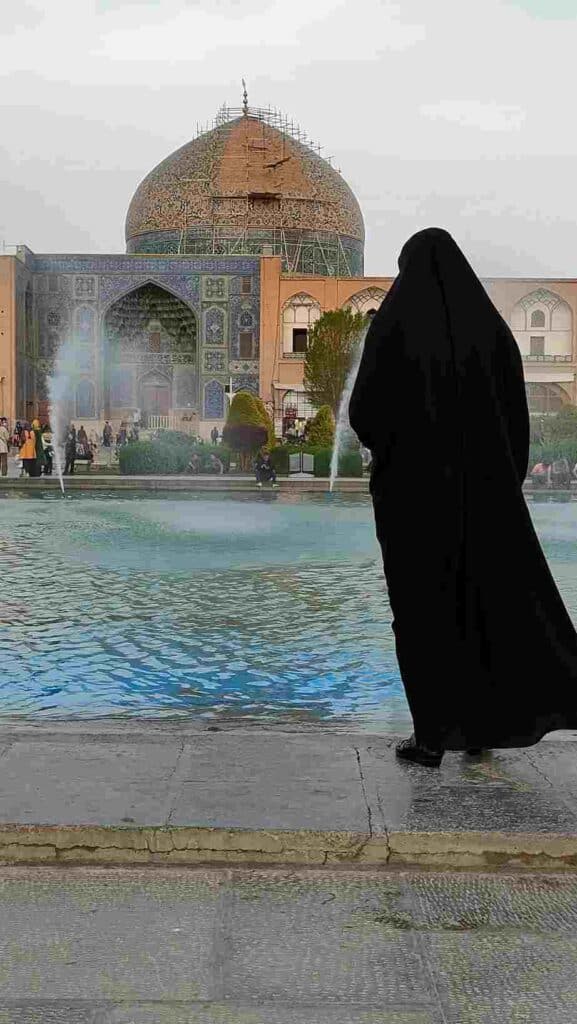
Average Iranian women wear stylish colorful dresses, often color their hair blond, or young girls even to other colors, use nail polish, and wear strong make-up and lipstick. They wear leggings with a long cardigan or jeans with a slimmed manteau and often go out in tight and shorter trousers that let their ankles be seen with a mid-thigh tunic. Foreign travelers can feel underdressed next to the fashionable clothing of Iranian women. Persian women like paying attention to their appearance, especially when it comes to special occasions, more than most Western women.
How to plan your trip to Iran
Book your flight to Iran: I always use Google Flights, Skyscanner or Wayaway to find the cheapest flight tickets worldwide. To get an extra 10% for your Wayaway Membership Plus program use my discount code VOG
Important: Booking.com and other common platforms do not work due to international restrictions in Iran. The only exemption is Skyscanner, where you can book both your international flight and accommodation in Iran!
Book your accommodation in Iran: Hostelworld.com offers a limited number of hostels. All other services are only available through local travel agencies, like 1st Quest.
Get your visa to Iran: 1st Quest or Tap Persia local companies can easily arrange your insurance for Iran
Book domestic flights, hotels, transfers, bus and train tickets, and local tours, all in one place via 1st Quest travel agency.
Another good thing is that by using my discount code, you get an extra 5% off your bookings: VOG%1stQ
Virtual Private Network (VPN): Use VPNExpress, the fastest and best Virtual Private Network to get access to blocked sites in Iran and to prevent hackers from stealing your private information.
Insurance to Iran: 1st Quest or Tap Persia local companies can arrange for you visa to Iran
Book local guides and local tours: Pirsik is specialized in offering tour guides and local tours in less touristic countries, including Iran.
You may be interested in this 2-week-itinerary for your first trip to Iran
If you want to learn more, this is a list of the best books about Iran
All you need to know before traveling to Iran (45 useful tips)
Where you must wear an abaya
When visiting a mosque, you must wear an abaya as a female traveler in Iran.
Abaya is a singly piece of cloth that women wrap around their bodies on top of their regular dress. You should wear the abaya in a way that it does not let a single hair stand out from under the abaya, your arm is covered to the wrist, and apart from your face, no other skin part is seen.
They are usually white with colorful patterns, not black, and are available at the mosque’s entrance. So, you don’t have to think about where to get one. The only exemption during my trip to Iran was Mashhad, where they were not prepared with an abaya for visitors at the entrance. But shortly, the tour guide of the holy shrine arrived with an abaya I could keep.
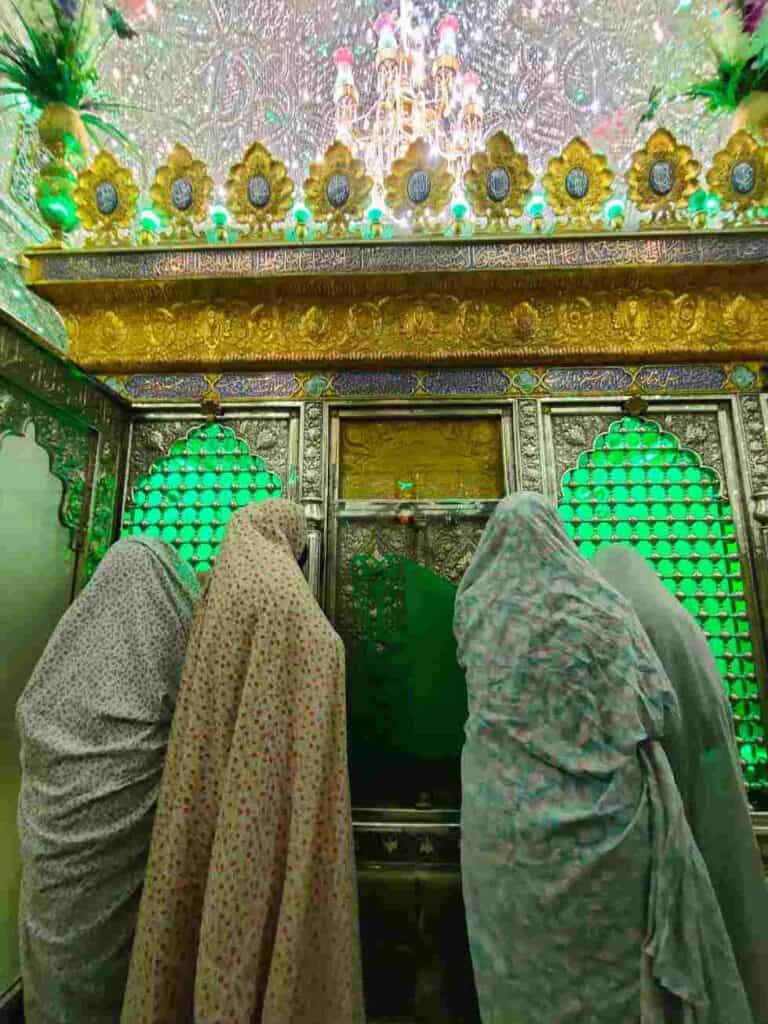
What color of the dress can women wear in Iran?
It is one of the misbeliefs that women must wear black color in Iran. As I already mentioned, seeing women walking in black chadors is common, but it is not compulsory.
You can wear any dress of any color in Iran, including pink, yellow, blue, green, or whatever. There is no restriction about that.
Apart from the dress code, there are other rules in Iran that you must abide by.
Read my post about what you can and cannot do in Iran.
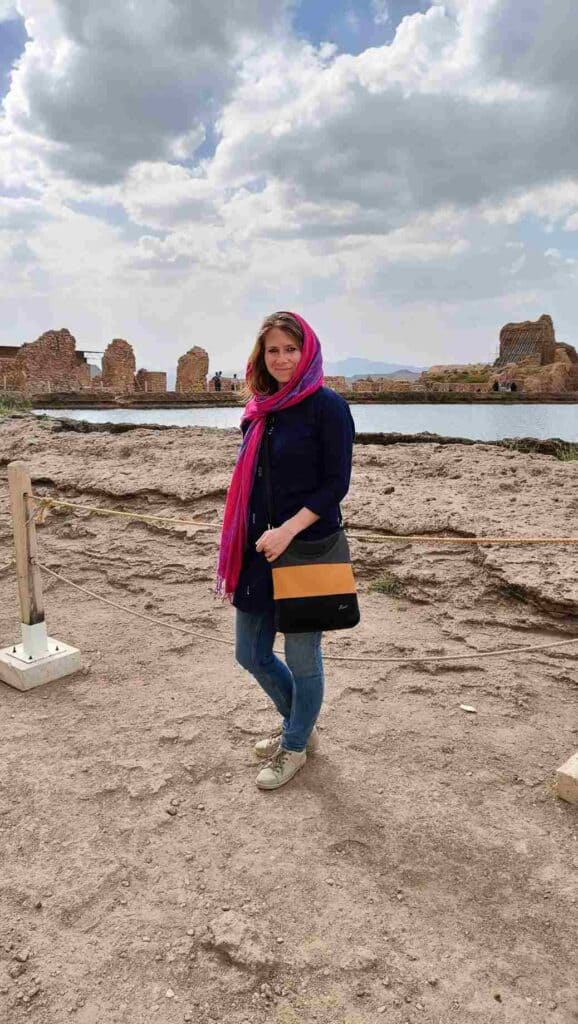
How should women travelers exactly dress in Iran?
As a woman tourist in Iran, you can wear a longer mid-thigh shirt with long pants (jeans, even skinny jeans, leggings, or other trousers) and a scarf of any color. The shirt must have at least ¾ sleeves. Even white pants are acceptable if not transparent.
You can also wear jeans with a short T-shirt if you have a light cardigan with ¾ sleeves that covers your bottom.
As for shoes, you can wear sandals without socks and nail polish. However, if you are traveling around, it may not be the most practical.
Having nail polish and make-up is totally acceptable and not against the dress code in Iran.
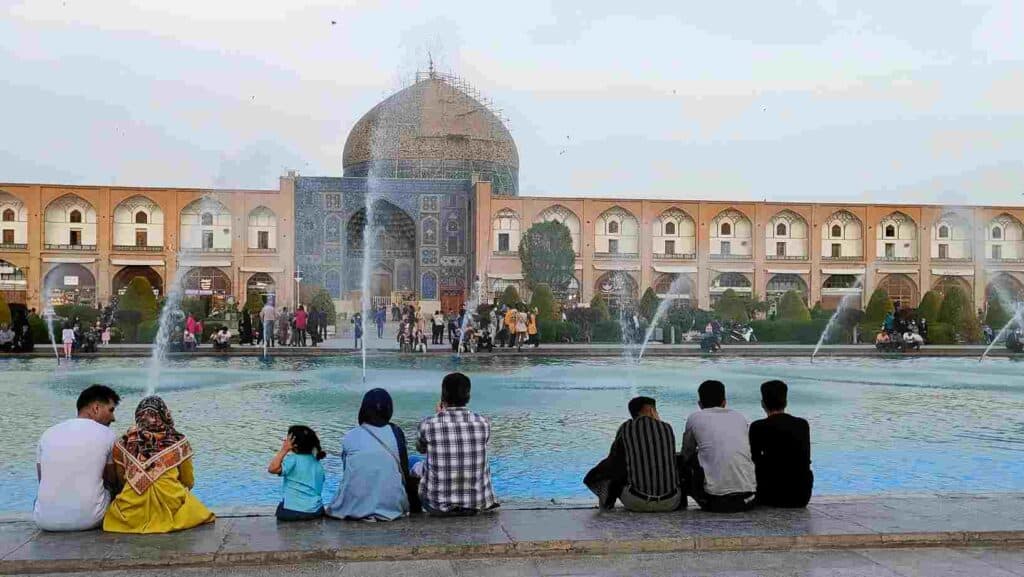
Dress code for swimming in Iran
Iran has long beaches in the north at the Caspian Sea and in the south at the Persian Gulf. Kish and Qeshm island, or Ramsar, are also popular among tourists and locals. But going on a beach holiday in Iran is different than in other countries as foreign travelers have no exclusive beaches to put on their bikinis. Iranians go swimming in clothes and scarf.
Only swimming pools have a separate time for women and men where you can wear a swimming suit. But in public places, the same dress code applies as anywhere else. It does not hold back Iran women from enjoying the water, but it seems uncomfortable for a Western woman.
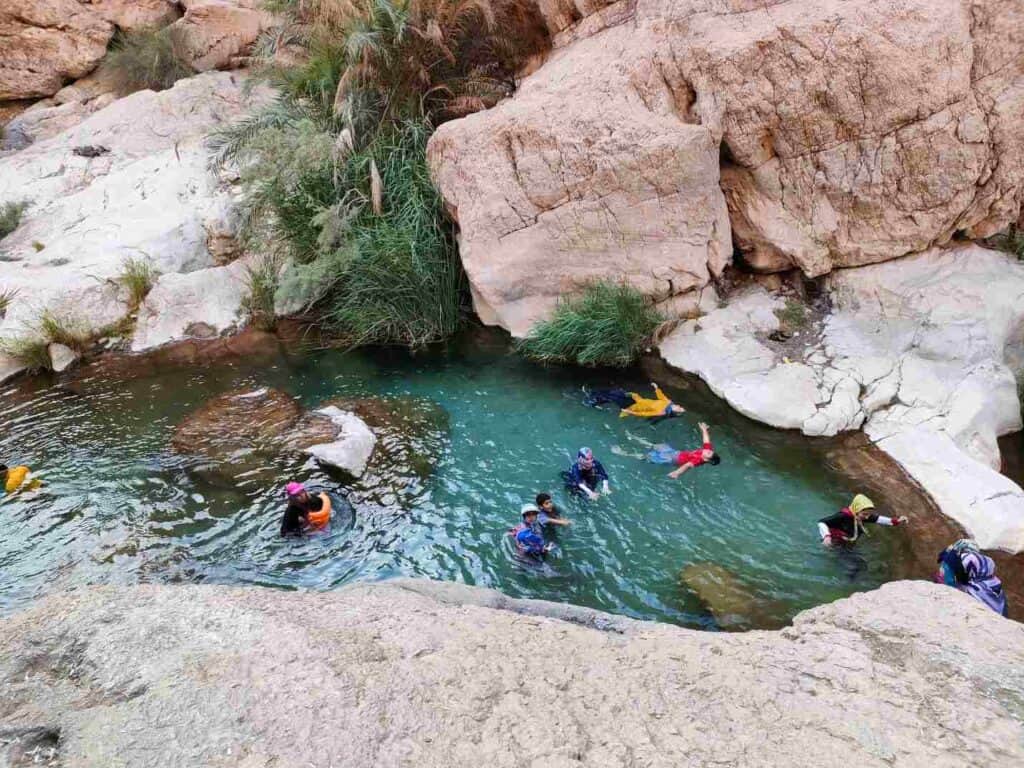
When do you have to wear the scarf?
When you leave the plane, you must cover your hair with a scarf and wear a mid-thigh manteau or cardigan according to the Iranian dress code.
Because of that, always keep the headscarf and the appropriate dress in your carry-on luggage!
However, when boarding your flight to Tehran, there is no need to wear a scarf. As you will see, hardly any Iranian women put on the scarves before the actual landing in Tehran. Just follow what they do.
After that, you must wear it in public places during your whole stay in Iran. The only time you can get off your scarf is when you enter your hotel room or in some restaurants or shops where there are mainly tourists; the owner will let you know if it is no problem to remove the scarf.
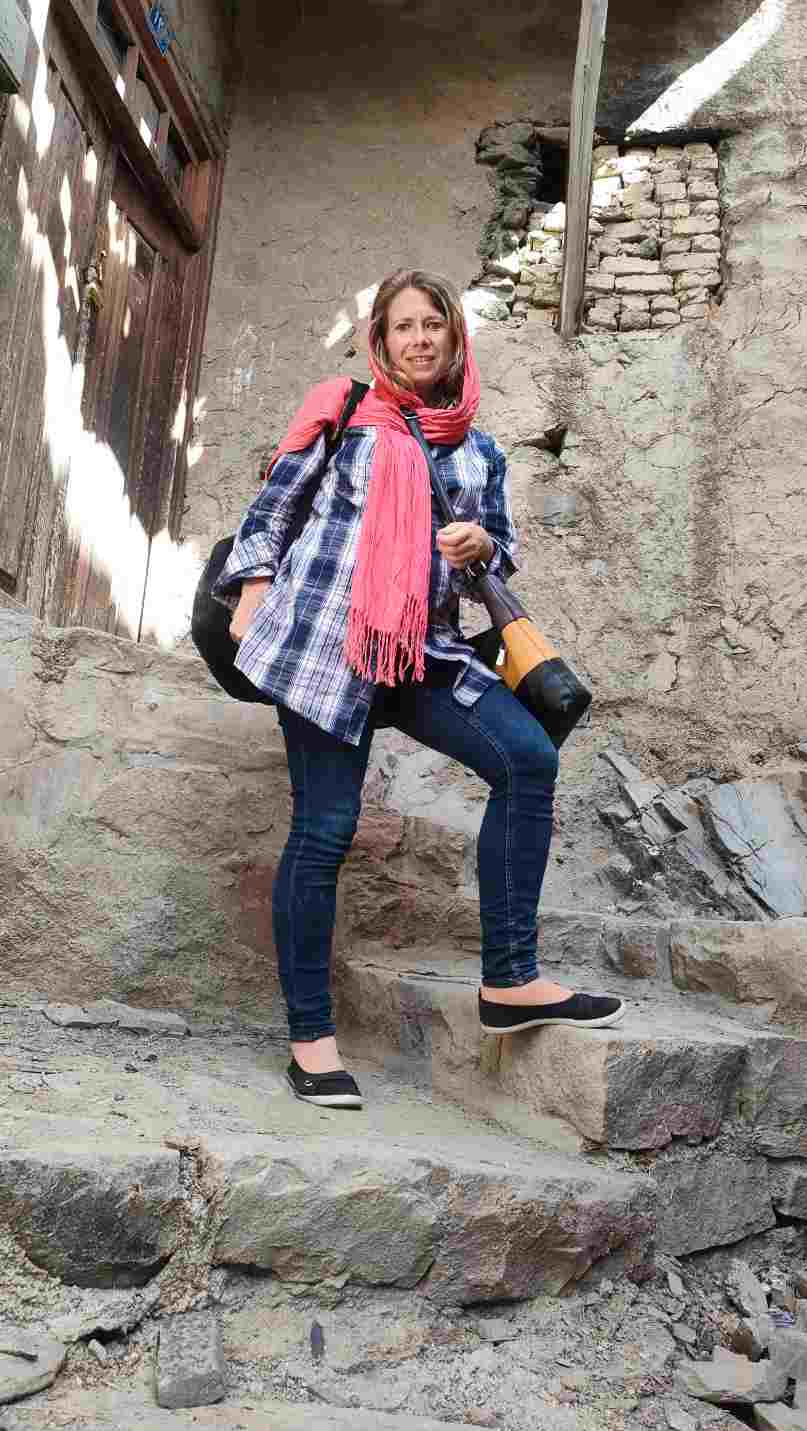
Also, if you are with only Iranian women in a home, you don’t have to wear a scarf.
Another important thing is that you must wear it while hiking in nature or doing sport. I never felt wearing a scarf in Iran was a big burden, except when I was walking in the summer in northern Iran in high humidity, and by the time I reached the top of the mountain, my hair was completely wet. But again, the dress code in Iran is not something that should keep you from traveling there.
Foreign female tourists usually struggle to fix the headscarf. As it is not attached to the hair; so it can easily slip. And you always have to adjust it. At the same time, you wonder how Iranian women can wear it without ever having to touch it. With time, you become more experiences with that.
And if you are wondering if it is necessary to keep the dress code in Iran for female foreign tourists, the answer is yes. It is not optional. Iran is such an amazing country, and it is a minor sacrifice in return for the experience.
What is the punishment for not wearing the headscarf in Iran?
Do not worry too much about getting punished immediately because the scarf slips down without noticing it. It happens to local Iranian women as well. Or, when walking with the backpack, the “manteau” can easily slip up without you noticing. In most cases, locals kindly warn you to fix your dress or scarf. Also, it is almost impossible not to lose the scarf for a short time in the stronger wind as it is not tied or fixed to the hair.
You probably don’t have too many appropriate clothes in your garderobe that complies with the clothing rules in Iran. But this is not a problem. You can easily buy on the spot upon arrival. I always take 2-3 cardigans or manteaus with me, and if necessary, I head to the bazaar or any shop and buy one. They sell it even in the Tehran undergrounds.
There is a “morality police” checking how women dress, but the control is nowadays less strict (although there are always exemptions and periods when things change). They are also more lenient towards foreign tourists.
The morality plus can show at shopping malls, in the city center, and along the highway.
First, the police give a warning only in the street to the person inappropriately dressed and take her to the police station. She is usually released with a fine or sometimes can get flogging. If she repeatedly breaks the dress code rules in Iran, she faces court procedures that can end up with a fine or imprisonment.
If foreign female travelers ignore the hijab and other dressing rules in Iran, they can get a fine, and be detained, and their visa may be revoked or deported from the country.
Male dress code in Iran
It is much easier for a male tourist to adapt to the dress code in Iran as there are only some basic rules to keep in mind. Men should wear long trousers and a T-shirt or a long-sleeved shirt. That’s it! You can wear three-quarter pants, if necessary, but this does not look that good.
Do not wear a sleeveless T-shirt and short pants as a male tourist in Iran!
According to Iranian culture, men should also not wear earrings.
Interestingly, men cannot wear ties since the Islamic revolution, as it has been seen as part of Western culture. For foreigners, it is not a problem, though. An unwritten rule that a man loyal to the government is unshaved.
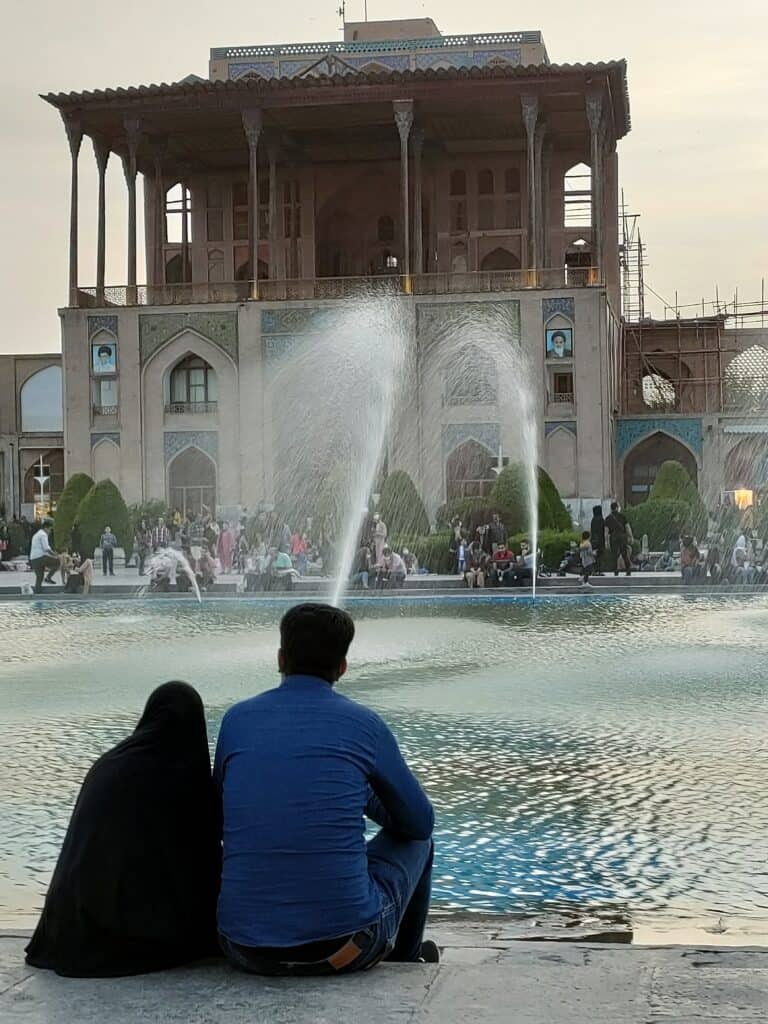
How the dress code in Iran has changed
Let me tell you more about the story of the dress code in Iran to see why it has always been a central topic. There was a time when wearing a headscarf/hijab was banned, but also when women voluntarily put on the hijab during the Islamic revolution.
Pahlavi Reza Shah banned the Islamic hijab in 1936 (Kashf-e hijab). It was part of his plan to turn a country with strong Islamic traditions into a Western, modern state in the shortest time possible. The ruling upper class welcomed this decision, but it was unpopular in conservative circles. The police had to remove the shawl from anyone who wore it in public. Some even committed suicide rather than removing the hijab. Several girls from conservative families refused to enroll in higher education. This order would probably have been a progressive step if the women could have freely decided to wear it or not. But as it was not a matter of choice. Many conservative women took it as an offense and preferred not to leave their homes until Reza Shah was dethroned in 1941.
His successor, Mohammad Reza Pahlavi (1941-1979), lifted the ban on the hijab, but wearing a headscarf was a stigma for women and made it hard for them to get into the higher strata of society. It was considered old-fashioned and a sign of belonging to the lower class.
From the 1970s, it was suddenly no longer the sign of conservatism. It became a symbol of virtue and was a way to reject the forced modernization of the Pahlavi shah. Unveiled women were judged as infected by the morally weak Western culture, and wearing a hijab became popular again. Thousands of women covered their hair with a scarf and participated in the anti-Shah demonstrations during the Islamic Revolution in 1979. This is how the headscarf became a sign of resistance against the Shah. Women temporarily covered themselves to expel the Shah, but high and middle-class women had no intention to wear it after.
After the Islamic Revolution of 1979, the country changed from a monarchy to a theocracy based on Sharia law, imposing stricter clothing and behavioral rules on the people.
In the beginning, there had been many attempts to impose the veil, but all these failed because women resisted.
However, from 1983, wearing a hijab up has become compulsory again.
Clothing in Iran today
Iranian girls start wearing a hijab (headscarf) when they go to school, but they may still wear T-shirts and a ready-made hijab, called “Maghnae” covering the body below the shoulders. Usually, schoolchildren and students have black, dark blue, or green uniforms. It covers the hair but does not need to be tied or adjusted. Later, they switch to the comfortable manteau and scarf.
When a nâmahram (not close relative) man is about to enter a room where women may have removed their hijab, he will announce his arrival with yâllâh, yâllâh (an invocation of God’s name). Women put on their scarves or chadors to permit the man to enter.
Nowadays, many pious women wear manteau rather than chador. Only in the South of Iran, in the Persian Gulf, do Sunni Arab women wear a special mask and a black chador.
Others must wear a chador even if they do not want to because of work requirements (e.g., in some governmental agencies and universities) rather than by personal conviction.
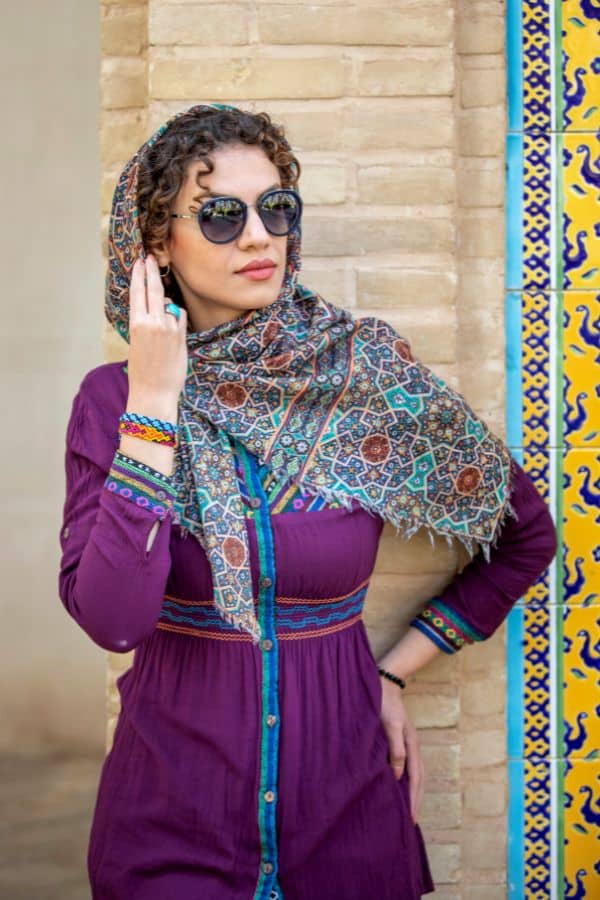
Today, the Iranian clothing rules give much more freedom. Women cover their hair with a scarf only halfway so that their hair stands out. And if the shawl slips down, they put it slowly back. It is not a big issue.
When there are only women present, there is no reason to hide. Only the women of conservative religious families wear the shawl at home as well.
Otherwise, they wear scarves and short dresses with décolleté. Although prohibited by law, there are regular mixed-gender parties at private houses where women take off their coats and spend the evening in a spectacular evening dress without the hijab. Many already arrive in miniskirts and wear unique and expensive jewelry sets with precious stones.
The younger generation regularly protests against the mandatory clothing requirements. The upper classes follow the rules more loosely, but some women support them.
What to pack for a trip to Iran?
If you are looking for some recommendations about clothing in Iran, you find some here. As I said, it is enough to take only a few, as you can buy on the spot if needed.
1. Women’s Casual Lightweight Long Sleeve Cardigan
This is a light summer-type cardigan you can wear on top of any shirt. It is available in your preferred color. Cardigan is practical because you can wear it multiple times while changing only a T-shirt below. Try to look for the thinnest material when you travel to Iran in the summer.
2. Women’s Lightweight Longer Length Cardigan Sweater
This is a practical longer-length cardigan that you can wear on top of a T-shirt. Similarly, you can change your shirt daily and keep the cardigan on top. Check out the different colors. It is still lightweight, a bit thinner, and ideal in cooler temperatures.
3. Women Scarves
If you need a set of scarves for your trip to Iran, you can buy some of these stylish scarves according to the color of your choice. It is affordable and perfectly suitable for your trip. You can use them later as well.
Iran is the only country where foreign women must also keep the same dress code as Iranian women. However, it does not mean wearing a chador. Every female tourist must wear a headscarf/hijab, although they are usually more lenient with foreigners. The official dress code rules in Iran have not changed, but the control is less strict, allowing women to dress much more relaxed and stylishly. The dress code for male tourists is simpler, and they do not need to think much about how to dress up appropriately in Iran. Wearing a hijab has been a central topic in Iran for a longer time.
Other articles about Iran
What you can and cannot do in Iran
45 things you must know before traveling to Iran
The best books to read about Iran
The best 2-week itinerary in Iran (the classical route)
The best 2-week north Iran itinerary
All you need to know about the Iranian currency
The best places to visit in Tehran (museums, palaces, religious sites)
The best things to do in Tehran
Travel guide to Tabriz, North Iran
Travel guide to Mashhad, the holy city of Iran
Best things to do in Lahijan, the city of tea in Iran
Best things to do in Ramsar at the Caspian Sea
Visit Varzaneh desert, Toudeshk, Mesr desert and Garmeh from Isfahan
More articles about the Middle East
Pin it for later!
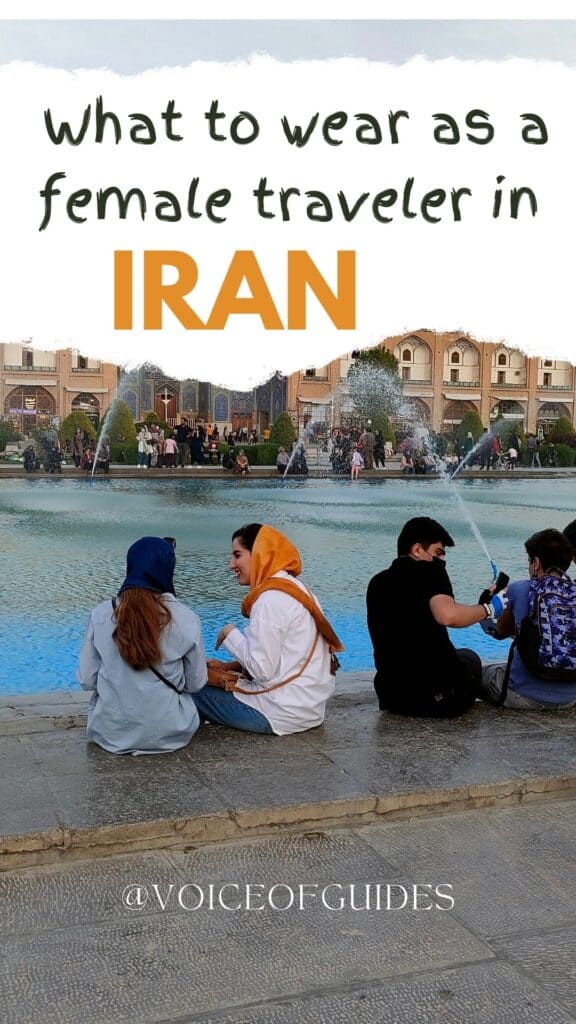

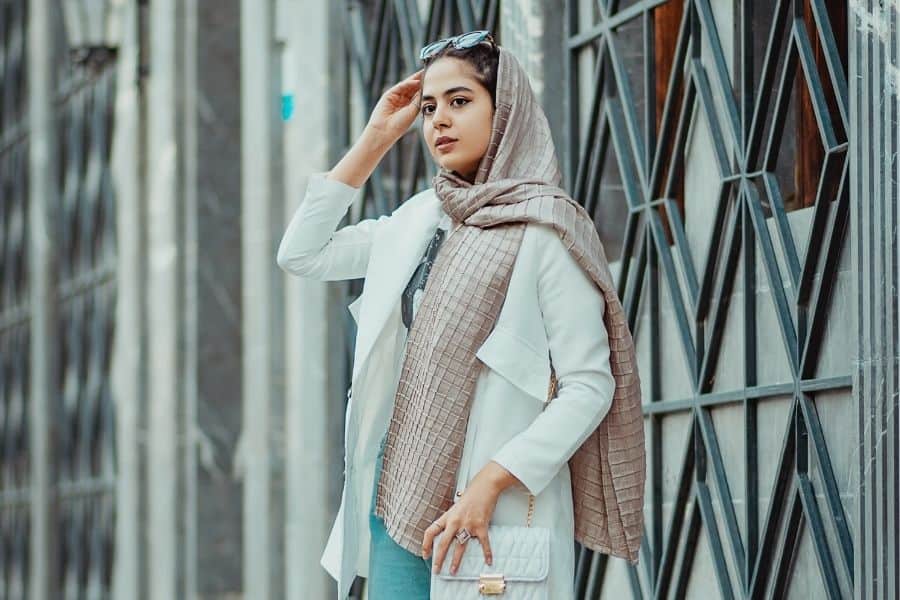

The scarf link for Amazon goes to the heavier weight cardigan.
thanks for letting me know.There were apparently some changes. It is updated now.